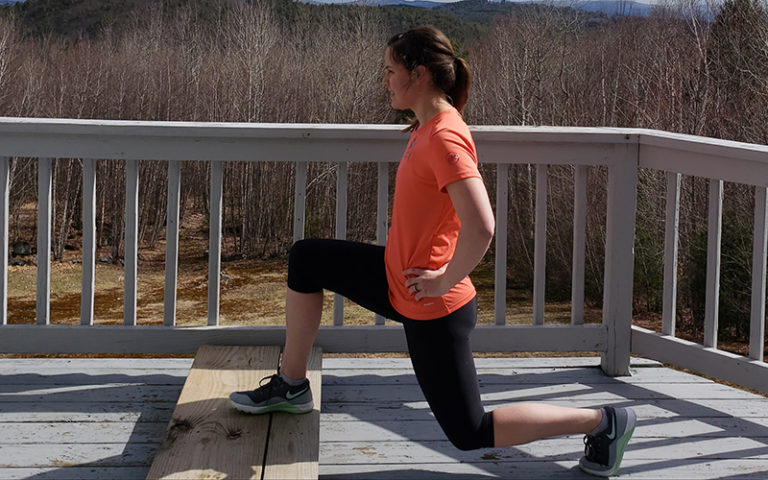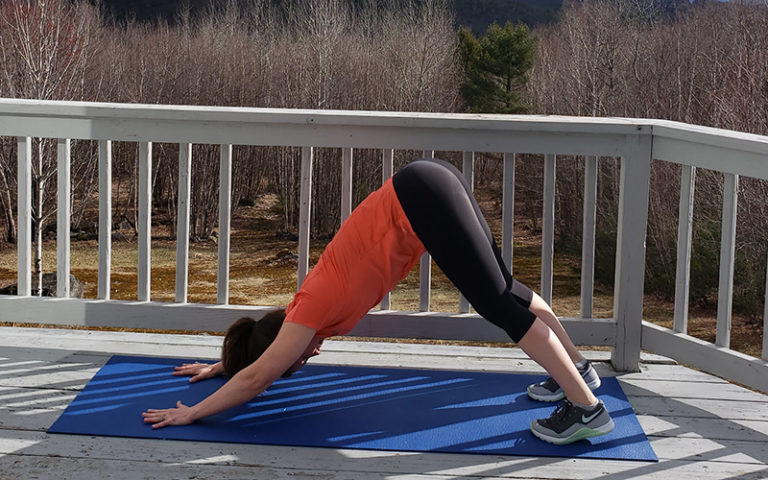
If you’re like us, you can’t wait to get back out to the trails for a hike. In the meantime, try this home workout that will help keep you in hiking shape.
Try these exercises to stay in paddling shape or this at-home rock climbing workout.
Whether you’re still in the depths of winter or entering mud season, there’s a good chance you haven’t been doing much hiking recently. For a dose of inspiration and some hiking exercises you can do in your living room or backyard, we caught up with Kathy Ellis, M.S.—a licensed personal trainer, certified yoga trainer, and volunteer Class 2 excursions leader with AMC’s New Hampshire chapter. Ellis has trained clients of all fitness levels in every setting, from private studios to corporations, and currently works as a health and corporate wellness consultant.
“Many folks that I’ve hiked with in the past argue that nothing can prepare the mind and body for hiking other than getting out there and hiking. The same goes for water sports,” she says. “I agree that aspects of mental endurance, judgement, and skill can only be mastered on the trail or on the water, but I strongly believe building a foundation of muscular strength, endurance, and flexibility can set us up for optimal performance, fun, and less pain.”
Lucky for us, Ellis put together a special at-home strength and conditioning circuit specifically aimed at building strength and flexibility in hikers so that when trails open back up, we’re ready. For maximum impact, she recommends completing 2 to 4 rounds of the entire circuit 2 to 3 times per week.
Disclaimer: Always consult your primary care provider before starting or increasing the intensity of exercise.
Warm-up
Be sure to warm up to get the blood flowing through the muscles for at least 5 minutes before starting the circuit with movements like walking around the house or going up and down stairs, if available. Range-of-motion exercises like arms circles, shoulder circles, controlled hip swings, shallow body weight squats and lunges are also great to help warm up the body.
1. Reverse lunge off step with knee lift

Muscles: glutes, hamstrings, core
Begin with both feet on the bottom step, facing up the stairs. Slowly step backwards into a lunge with your right foot, bringing the right knee as low as it feels comfortable without touching the floor. Power through the left supporting leg to shift body back up over the step, lifting your right knee up in front of you (balancing on the supporting leg)—up to hip height if possible. Without touching the step, step back again and repeat 10 times on the right side before switching to the left.
Equipment needed: Standard stair or 6- to 12-inch step
Reps: 10 on each side
Modifications: Add resistance by wearing your pack or holding free weights by your sides
How it helps hikers: Building strength and power is essential for those steep inclines and scrambles, and training joint receptors to stabilize and build balance for rocky descents.
2. Spinal balance with knee to elbow touch


Muscles: glutes, upper back, lower back, abs, shoulders
Begin on all fours, with your fingers spread wide, shoulders stacked over wrists, and hips stacked over knees. Inhale lifting the right arm up while lifting the opposite leg backwards and flexing the foot. The hips should remain parallel to the floor throughout this movement, engaging the core. (visualize tucking your belly button to your spine) Exhale as you pull your right elbow and opposite knee in to touch. Inhale, extending the right arm back out while lifting the opposite leg backwards. Repeat for 10 total repetitions before switching sides.
Equipment needed: Mat or towel for knees
Reps: 10 on each side
Pace: Move with your breath
How it helps hikers: Strengthens the core to prevent pain and strain.
3. Kneeling half stand-ups



Muscles: glutes, hamstrings, quadriceps
Begin in a half-kneeling position, with one knee up and the other on the floor and your hands on your hips. (use a cushion if needed under the knees) Shift your weight into the “up” leg and press into the floor to come up into a half-squat, keeping your knees slightly bent and feet shoulder-width apart. Lower back down to a kneeling position, this time with the knees in the opposite. Now, step up to the half-squat position to complete the rep.
Equipment needed: Mat or towel to cushion knees
Reps: 20
Modifications: Wear a pack or hold free weights to add resistance
How it helps hikers: Feel the burn! This movement builds strength and endurance in the quadriceps, essential for stabilizing the knee joint during a descent.
4. Downward facing dog to high plank


Muscles: shoulders, upper back, abs, lower back, glutes, hamstrings, calves
Setting up downward facing dog: From all fours, tuck your toes under and lift your hips toward the ceiling into an inverted V. Pushing into the hands and pressing back through the balls of the feet. Keep your spine long and the ears between your biceps reaching the crown of your head toward your thumbs and relaxing the shoulders away from the ears. Press your heels toward the floor to feel a gentle stretch through the back of the leg (hamstring and calves), keeping the knees slightly bent to start if needed.
Inhale as you shift your hips forward into a high plank (or, the top of a pushup), keeping your fingertips spread apart, shoulders over your wrists, and your core engaged. Exhale as you return to a downward facing dog, pressing your upper body toward the tops of your thighs while pressing your heels back toward the floor. Inhale and shift back to a plank. Repeat with the pace of your breath, finding more space and a deeper stretch with each exhale.
How it helps hikers: Mat
Reps: 15 to 20
Pace: Move with your breath
How it helps hikers: These lengthening exercises are essential for mobility and stability of the spine, hamstrings, and calves that can help promote good posture while carrying a pack and also helps reduce pain and strain in the areas that tend to fatigue toward the end of a hike.
5. Single leg squat off step


Muscles: glutes, quadriceps, core
Stand tall on a step, facing down the stairs. Lift one leg out in front of you. Balancing on the opposite leg, bend your knee and slowly lower your hips until the heel of the extended leg lightly touches the floor. Pause for a moment and push yourself back up to the starting position. Complete 10 repetitions on one side before switching to the other. Hold onto the railing if needed but work toward being able to stabilize without holding on.
Equipment needed: Standard stair or 6- to 12-inch step
Reps: 10 with each leg
How it helps hikers: This exercise is all about deceleration and knee stabilization to help reduce pain during a decent.
6. Side plank with rotation


Muscles: shoulders, obliques, hips, abdominals, lower back
Set up for the side plank by lying on one side with your feet stacked one on top of the other. Inhale as you lift your hips to come into a side plank, your weight resting on your forearm, your palm down and relaxed on the floor, and your opposite arm reaching up toward the ceiling. Engaging the belly button toward your spine, exhale, sweeping your top arm down toward the floor as you rotate your rib cage downward, “threading the needle” with your arm through the space between your torso and the floor. Inhale as your return to the start position. Complete 10 repetitions and switch sides.
Equipment needed: Mat
Reps: 10 each side
Pace: Move with your breath
How it helps hikers: This is one of my favorite core strength exercises as it really targets the obliques. A strong core protects the back from injury, especially when twisting with extra loads (like a pack) while maneuvering scrambles.
7. Curtsey lunge with knee lift


Muscles: glutes, hips, hamstrings, quads, core
Start from a standing position with your feet shoulder-width apart and step your left leg behind you and to the right so your thighs cross, bending both knees as if you were curtsying. Make sure your front knee is aligned with your front ankle. Return to standing, balancing on your right leg, lifting your left knee up in front of you to hip height. Return your left leg behind you in the curtsy lunge without touching the floor, if you can. Repeat 10 times and then switch to the other leg.
Equipment (optional): wear your pack or hold free weights
Reps: 10 on each side
How it helps hikers: This is one of my favorite hiking preparation exercises because it helps stabilize the hips making you more confident navigating boulders and rocky terrain.
Cool-down
Ellis suggests these two stretches to cool down after your circuit:
Pigeon hip opener
Muscles: piriformis, psoas
From a downward facing dog position, bring your right knee forward, placing it just outside your right hand. (shift your hands closer together in front of you, and extend your left leg behind you) Pull the right heel in toward your left hip, or if your hips are more open, scoot your right foot away from you. Make sure your left hip stays square to the mat. Walk your hands out in front of you or come down to your forearms, allowing your torso to relax over your right knee. Hold here, breathing into any areas of tightness and tension for 30 to 90 seconds. Repeat the stretch on the other side.
Modifications: Can do this supine (lying on your back, opposite-down four stretch) or seated in a chair (cross ankle over opposite knee and lean gently forward).
Assisted hamstring stretch
Lie on your back and place a strap or towel around your foot. Hold the ends of the towel and use it to gently lift your leg up. Keep your knee as straight as you can and hold the stretched position for at least 30 to 90 seconds.
